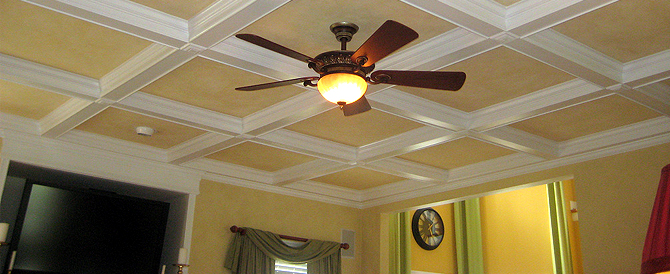Welcome back for the second part of our three-part series on basement options! Like we said in Part 1 of the series, we know that there are many decisions that go into refinishing or remodeling a basement. Some of those decisions will be based solely on the needs and wants of the homeowner having the work done. Others are decisions that may be overlooked or hastily made. That’s where we want to focus for this series.
For today’s post, we’re going to discuss some of the options homeowners have for finishing the ceilings in their basement. The ceilings are almost always the last thing homeowners consider when remodeling any room. However, when planning out your new finished basement, it’s even more important to consider your ceiling options. In most homes, pipes and wiring in basement areas are usually along the ceiling, and access to and camouflage of these vital components must be kept in mind when deciding on a ceiling.
So, ceiling choices are governed in large part by the particular basement’s design. The height of the ceiling and the prevalence of utilities like plumbing, electrical and heating/cooling ducts play a major role in your available choices. With this in mind, we recommend the following ceiling options for finished basements:
• Drywall Ceilings Made For Accessibility.
One advantage to using a drywall basement ceiling is that it affords the same finished look as the rest of the house. However, there are circumstances when drywall isn’t the best option. For example, you will need access to plumbing and/or gas connections. You can still use a drywall ceiling, but you’ll need to incorporate access panels to plumbing/gas/electric connections. That sometimes will change the smooth and similar look of the rest of your dry-walled house.
• Suspended Ceilings.
Suspended or “drop” ceilings don’t need to look like the ceiling in your dentist’s office. They’re convenient in that they offer accessibility to whatever’s above them. They also work well in situations where you have pipes that hang below the structural joists because the ceiling is suspended at a lower height than the bottom of the joists. Suspended ceilings have come a long way and now offer smooth, textured or imprinted finishes and an attractive appearance. One thing to remember, however, is that you’ll need to have sufficient floor-to-ceiling height to use a suspended ceiling, because it installs lower than a drywall ceiling attached to the joists.
• Install A Sound-Deadening Ceiling.
Installing a basement ceiling that helps cut down on sound transmission to the floor above is a good idea, particularly if you want to install a home theatre with surround sound! One way to do this is to install resilient channels to the ceiling joists. The ceiling is then fastened to these channels. You lose a small amount of ceiling height – about an inch or less – but it may be worth it to help keep the area quieter. Suspended ceilings also offer some sound reduction, especially if you install acoustic panels designed to absorb sound.
• Go With A Different Look Altogether.
Why not shake things up and use a tin or wood-look ceiling? Your ceiling doesn’t have to be a plain smooth white surface. These products can give the space a unique style relative to the rest of your home.
• Wow Them With A Coffered Ceiling.
For a total departure, go with a coffered ceiling. They’re certainly dramatic and an interesting style statement. You can have them custom-built or you can buy coffered ceiling kits. This may not be the right kind of ceiling for every basement; but for some, it could be the right choice for a truly different design departure. Just be sure you have sufficient headroom to accommodate this type of ceiling.
We’ll see you again for the final part of our three-part series on Basement Options, where we’ll discuss the choices homeowners have for windows and lighting.
*image courtesy of Brian Moloney/Flickr.com

